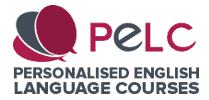An Easy Method to Learn English
It is my contention that there is no single easy method to learn English. Rather, any language learning “method” should comprise a series of interlinked strategies and tasks which work together to bring about the acquisition, and subsequent fluent verbal production, of a foreign language.
When a new student enrols on one of my courses, the same old questions run through my mind during the first few months of our cooperation, such as:
- How can I get the student’s English speaking skills from a state of intermediate mediocrity to free-flowing and reasonably accurate language production (i.e. an advanced level)?
- Can I get the student to cut out fossilised grammar mistakes?
- How can I help the student memorise English vocabulary more effectively?
If a student of mine is able to pay serious heed to the above questions and accept that they also need to learn English independently, then they will have the right mindset to be able to implement and benefit from the easy method to learn English I shall outline below.
Developing an easy method to learn English
As previously mentioned, any method to learn a language should consist of a series of interlinked steps to bring about the best results. Here’s how I would go about elevating your receptive skills (namely, listening) and productive skills (speaking and, to a lesser extent, writing):
Step 1 - Find materials which are both ‘Comprehensible’ and ‘Compelling’
As a first step, it’s vital that you seek out input which is both ‘comprehensible’ and ‘compelling’. I have purposely selected the words ‘comprehensible’ and ‘compelling’ because they are central to two hypotheses of second-language acquisition put forward by the great American linguist, Stephen Krashen. Let’s get the theory out of the way first before we consider the topic of selecting materials:
The Input Hypothesis
Krashen came up with the Input hypothesis in the 1970s. Essentially, the hypothesis posits that learners best acquire a second language when they expose themselves to input that is slightly more advanced than their current level of proficiency. Therefore, this input should present a certain level of challenge for second language learners. Nevertheless, the input should still be ‘comprehensible’ as learners are able to make use of the extra-linguistic knowledge they have to decipher it. As the name suggests, extra-linguistic knowledge refers to:
- our knowledge of the world which we have gained as a result of our life experiences, career and education
- the situation at hand, i.e. the context
In summary, Krashen coined the term ‘Comprehensible input’ to describe how learners acquire language naturally through input and messages which they understand.
The Compelling Input Hypothesis
In addition to being ‘comprehensible’, input - that is learning materials - should be 'compelling'. At the heart of Krashen’s Compelling Input Hypothesis is the idea that when you receive compelling input, you simply acquire language regardless of whether you're interested in improving or not.
According to Krashen, reading or listening to compelling stories, having conversations with interesting people and watching riveting movies may be the only way we truly acquire language.
Our Model Learner of English - A Polish “Business Manager” at the B1 Level
For the purposes of describing an easy method to learn English, let’s imagine that our model learner is a male Polish Business Manager in his late twenties. His ambition is to work in a multinational company in the near future. The learner is at the B1 intermediate level.
Our model learner has found a text on the Internet called Cultural Expectations and Leadership. Therefore, the input should certainly be ‘compelling’ for our learner. The text is aimed at those at the upper-intermediate level (B2), thus ticking the boxes when it comes to ‘Comprehensible input’.
For the purposes of this post, here’s the text:
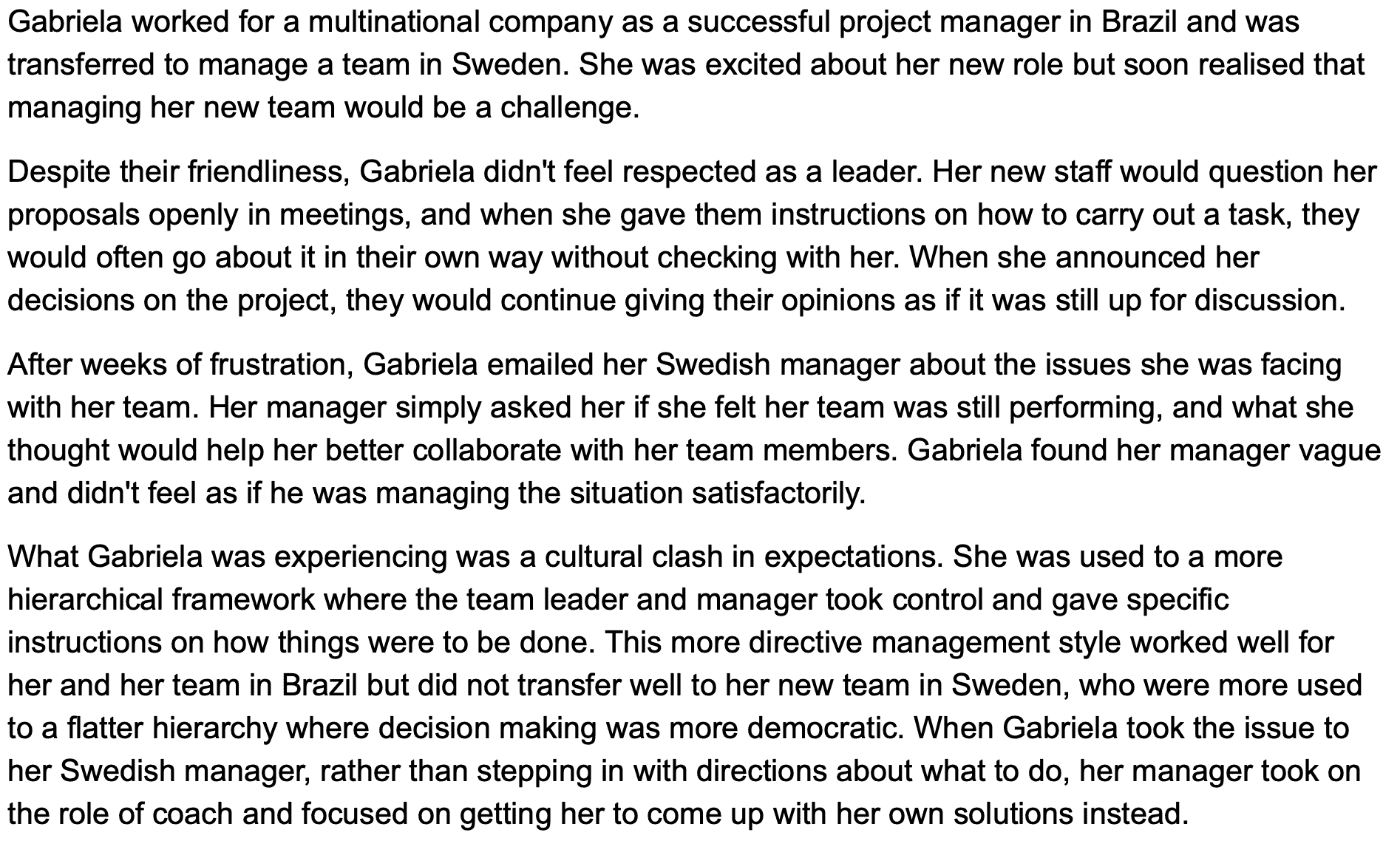
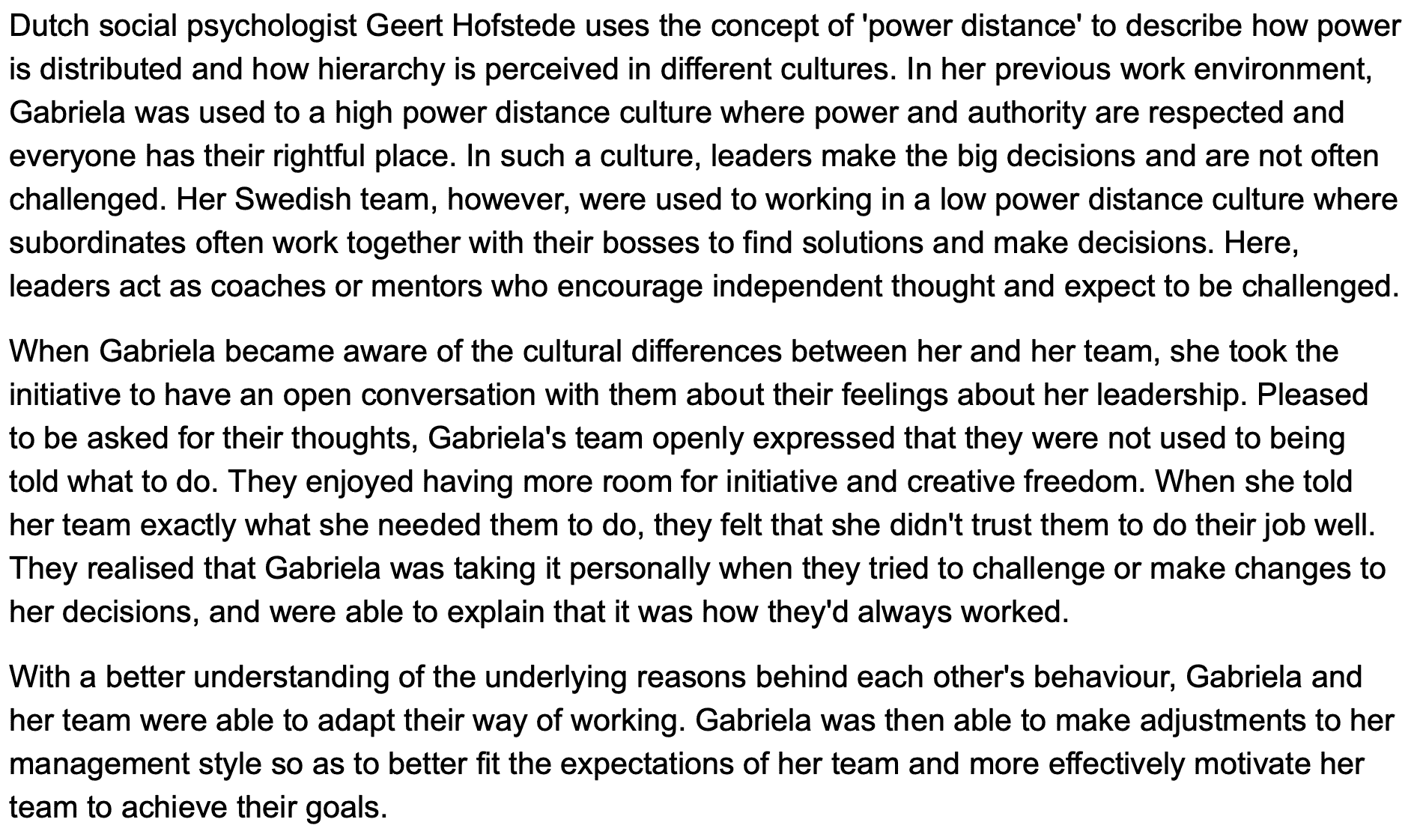
Step 2 - Engage in Deep Reading
All language learning methods should be thorough. When reading something, it’s no good just rushing through a text with the false belief that you will acquire language. You need to engage in deep reading, or slow reading. By deep reading, I mean contemplative and deliberate reading as opposed to superficial reading or skimming a text.
The contemplative reading of a text/article/chapter etc. should involve the following:
- Reading the target material slowly, to begin with;
- Reading the text several times, building up speed if necessary;
- Stopping at appropriate points to reread difficult phrases and sentences;
- Guessing the meaning of new words and phrases before turning to a dictionary or Google Translate etc.
Step 3 - Concentrate on words and phrases which you believe you could use in future conversations
Having engaged in deep reading, our Polish Business Manager could now home in on those new words and phrases which he can relate to in some way. In other words, the learner anticipates that he could make fair use of these words and phrases in his future conversations in English. Therefore, this learning of vocabulary should be very selective as opposed to all-encompassing. There’s no need to learn every single word or collocation under the sun.
From the text, let’s imagine that our model learner has picked out the following words and phrases:
- feel respected (as)
- to question proposals openly (question = verb)
- carry out a task
- go about (DOING something)
- collaborate (with team members)
- satisfactorily
- be used to (something)
- hierarchical framework
- directive (management style)
- independent thought
- take the initiative
- have an open conversation
- take something personally
- make adjustments (to)
As you note down key words and phrases, it’s advisable to add some additional grammatical information in brackets for the purposes of clarity.
So, our learner has picked out the vocabulary he wishes to learn. All he needs now is a vocabulary learning strategy to help him memorise words and phrases. The strategy should also allow for some freedom to add other grammatical information related to a word as well as meaningful sentences which contain the target word or phrase. This is where the Word-Phrase Table should come into play.
Step 4 - Word-Phrase Table - An Efficient Language Learning Strategy
For me, the Word-Phrase Table is a highly convenient strategy to store newly-learned vocabulary and also impart aspects of visualisation to aid long-term retention. Let’s explore the steps involved:
1. Create a Table on a Google Doc
In order to record new vocabulary, simply create a table with two columns on a Google Doc.
2. Record vocabulary with “future potential”
As I alluded to in step 3 above, it’s important to focus on words and phrases which are close to your interests and profession. It’s important that you assess the “weight” of these words and phrases. Do you expect to be able to use them on a regular basis in your future conversations and speeches etc.? In essence, when you come across a new word or interesting collocation, ask yourself - does this word or collocation have “future potential” for me? If it does, add it in a separate row in the right-hand column.
In the left-hand column, freely add translations in your mother tongue:
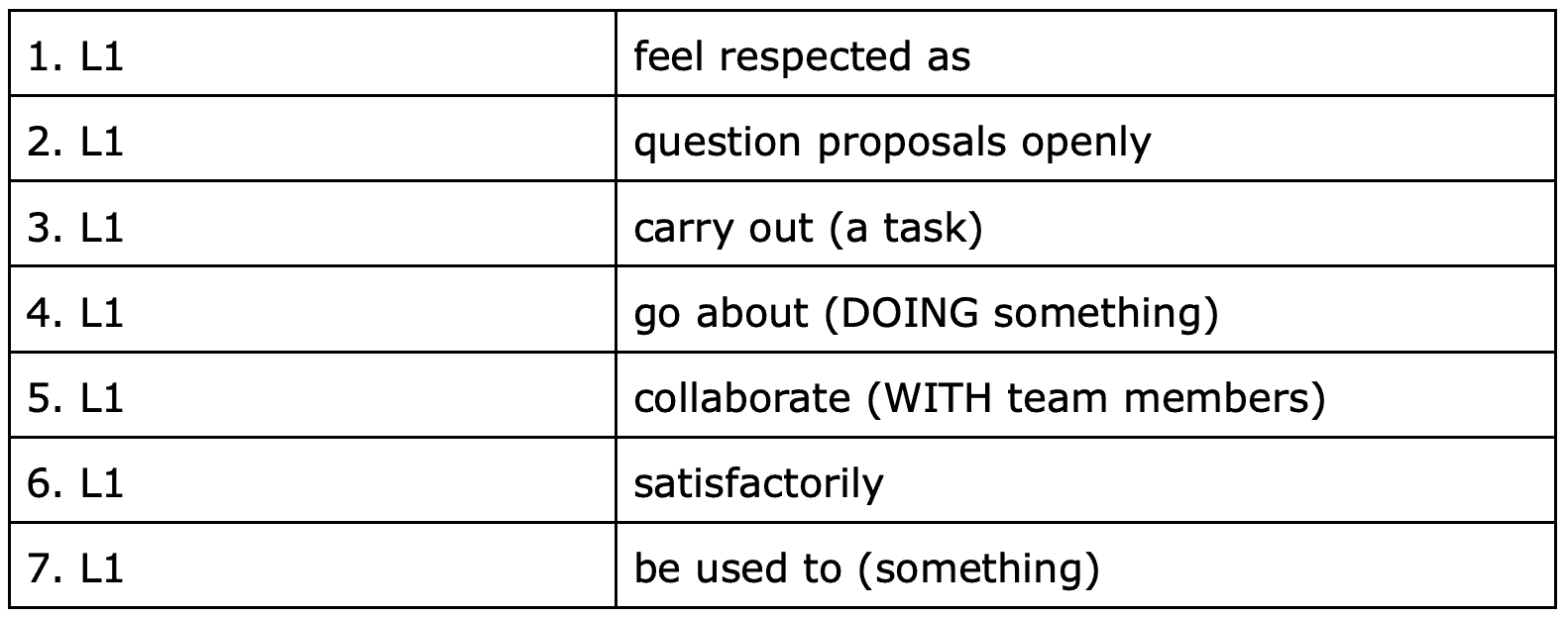
3. Add other vital grammatical information and collocations
Now that you’ve added the target words and phrases, you can include other grammatical information and collocations which are connected to each target word or phrase. If you need to, you can also add a definition for words and phrases which you perceive as ‘tricky’ or which have multiple meanings. The last three words/phrases from the table in 2. above are suitable when it comes to adding all this extra information:
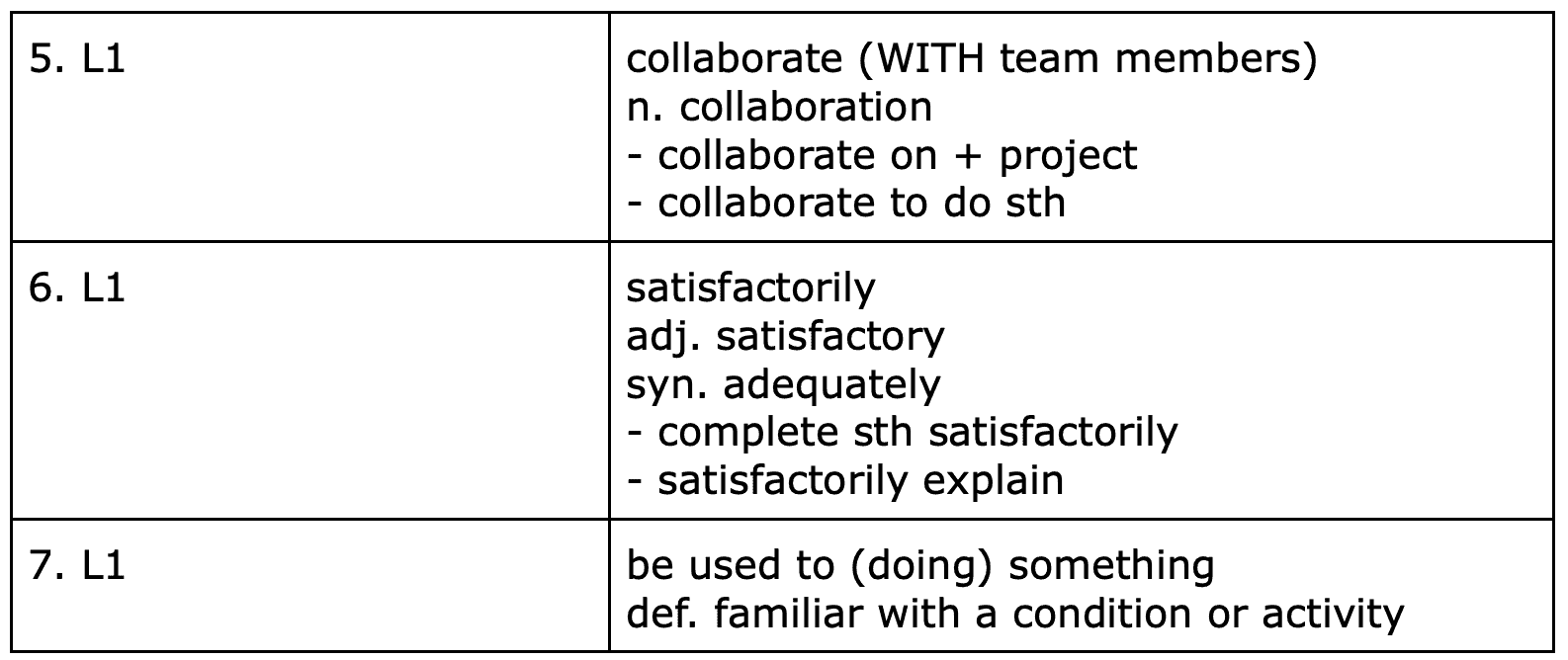
As you can see above, you can use abbreviations - n. = noun, adj. = adjective, syn. = synonym, def. = definition, and so on.
I preferred to put collocations after a dash (-) when I developed my Word-Phrase Table to help me learn Serbian.
4. Add personalised sentences
At the heart of our easy method to learn English is the need to create personalised sentences. By ‘personalised’ I mean sentences which document your past life experiences and wishes for the future. These sentences may also be in the form of opinions about pressing matters in your life. Finally, the sentences you create may provide information about people who are close to you.
The most important point about your personalised sentences is that they are true for you. Once again, we must return to the ‘future potential’ argument. How likely is it that you’ll want to retrieve these sentences in the conversations you have in English, be it in the near or distant future?
In terms of organisation on your Google Doc, I prefer to put personalised sentences after a star (*):
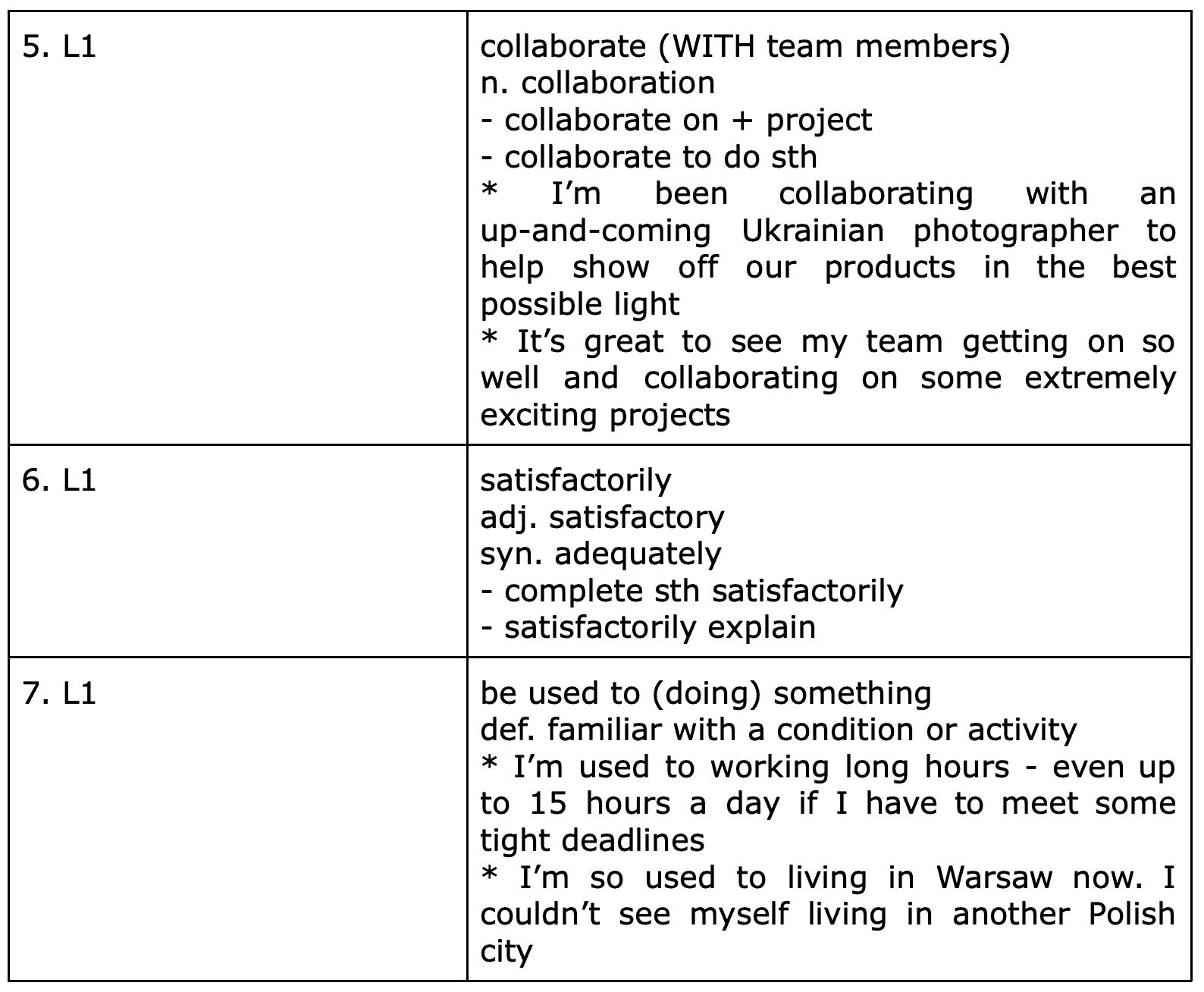
Note that you don’t need to add personalised sentences for every word, particularly if the target word is an adjective or adverb. I believe it’s difficult to come up with relevant sentences for these word classes.
5. Pay heed to the visualisation aspect of language learning
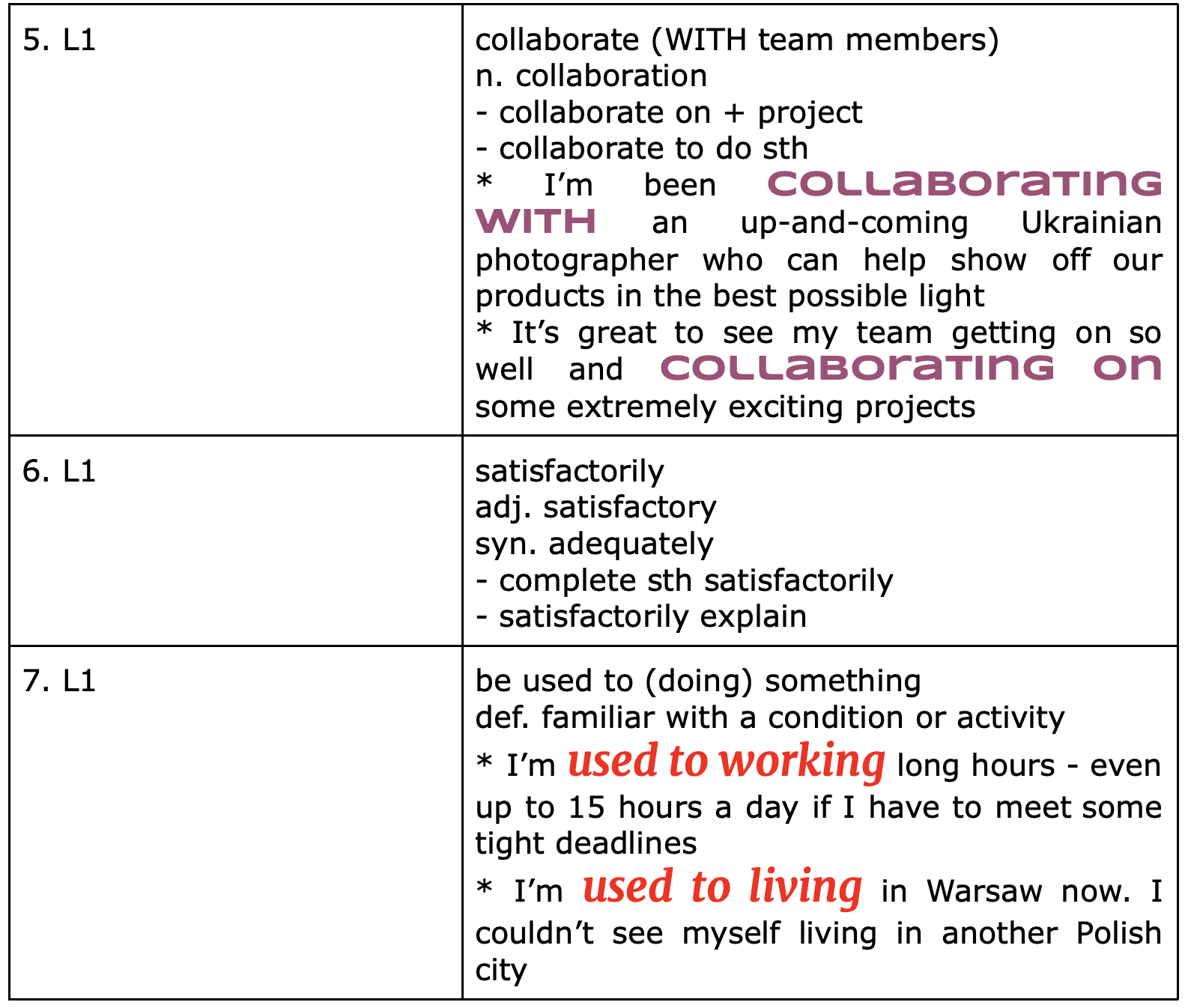
I’m a huge believer in using bright colours to capture and hold attention. As you can see in the Word-Phrase Table entries above, I’ve used the colour dark magenta 1 to help the collocations collaborating with and collaborating on stand out. I also selected the very distinctive font syncopate for the collocations. All in all, combining dark magenta 1 with the font syncopate creates very vivid visual associations, thus aiding retention. After several exposures to the personalised sentences as a whole, the brain should be able to create a link between ‘collaborating’ and the specific colour I selected.
6. Have spaced repetition and memorisation in mind
As you begin to add entries to your Word-Phrase Table on a regular basis, you need to think about reviewing material at systematic intervals (spaced repetition). To my mind, I don’t think you need an app to do this. As time passes, you will get a feel for how often you need to repeat material. Certainly, at the outset of the process, you should review material every day.
Regarding the personalised sentences, I accept that it’s mightily difficult to recall such long stretches of language word for word. However, with repeated exposure you will begin to find that the sentences are ‘swimming’ in your brain when you speak English. With the sentence below, for example, the main thing would be to memorise ‘used to working hard’. It can only be a bonus if you memorise everything else that goes around the target word or phrase:
I’m used to working long hours - even up to 15 hours a day if I have to meet some tight deadlines
The burning question is - what are the best ways to memorise personalised sentences?
I think there are two strategies which can aid the memorisation process and ensure the sentences are ‘swimming’ in your brain when you speak English. Firstly, you should favour whispering the sentences over reading them aloud. Reading aloud is more connected with pronunciation and intonation rather than deep reading and memorisation. For me, whispering helps me to focus, particularly when I close my eyes and try to recall (through whispering) whole sentences or parts of sentences.
Secondly, it’s a wise move to get your teacher or a proficient speaker of English to make audio recordings of your personalised sentences. Personally, I’ve never been much of an auditory learner. I’ve always been able to memorise material through rereading it, rewriting my notes (or sentences in this case) and visualisation techniques. However, I concede that visual and auditory learning styles do complement one another.
Final Thoughts
Over the years, I’ve taught far too many learners of English who were seemingly content with being stuck in their intermediate-level comfort zones. If you wish to get out of this state of intermediate mediocrity and achieve an advanced level of spoken English, you need to pour your heart into implementing and sticking to a language learning strategy such as the Word-Phrase Table I've outlined in this post. Moreover, you have to embrace the need to become an independent language learner. Language teachers can only do so much.
It would be a bit boastful to say that the method outlined in this post is the only easy method to learn English out there. However, I believe this method really does ensure you have useful chunks of language and personalised sentences on the tip of your tongue when you’re speaking English.
